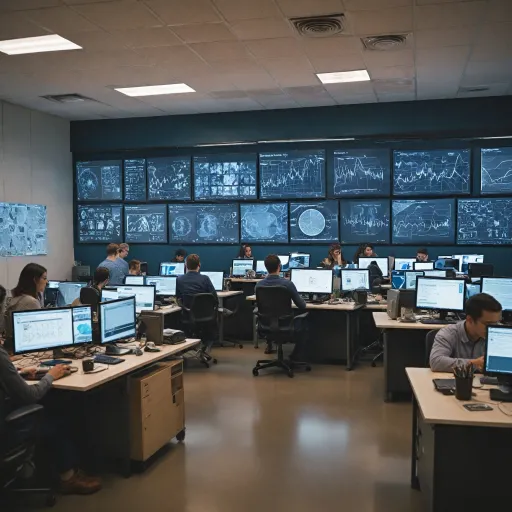
Understanding rpa in the context of human resources
What is Robotic Process Automation in HR?
Robotic Process Automation (RPA) is changing how human resources teams operate by using software bots to handle repetitive tasks. In the context of HR, RPA solutions automate processes like payroll processing, data entry, and benefits administration. These bots interact with existing HR systems and software, mimicking human actions to complete tasks faster and with fewer errors. RPA software, such as UiPath, is designed to integrate with various HR management platforms, making it easier to streamline workflows and reduce manual effort.
Why RPA Matters for HR Analytics
HR analytics relies on accurate and timely data to inform decisions about people management, employee engagement, and resource allocation. RPA bots can collect, process, and report on large volumes of employee data, improving the quality and speed of analytics. By automating time-consuming tasks like report generation and onboarding, HR professionals can focus on more strategic activities that enhance the employee experience and drive organizational performance. For a deeper look at how technology is boosting organizational performance, you can explore this resource on leveraging technology to boost organisational performance.
How RPA Fits into the HR Ecosystem
RPA is not about replacing humans but about supporting them. Bots take over repetitive, rule-based tasks, freeing up HR staff to focus on complex, people-centric processes. For example, automating payroll and benefits administration reduces errors and ensures compliance, while bots handling data entry can improve the accuracy of employee records. RPA solutions can be tailored to fit different HR processes, from onboarding to performance management, making them a flexible tool for HR departments of all sizes.
- Automates repetitive and time-consuming tasks
- Improves data accuracy for HR analytics
- Enhances employee experience by speeding up processes
- Supports HR teams in focusing on strategic initiatives
Understanding the basics of RPA in HR sets the stage for exploring its key benefits, the processes it can automate, and the best practices for successful implementation. As organizations continue to seek efficiency and better employee engagement, RPA is becoming an essential part of the HR analytics toolkit.
Key benefits of rpa for hr analytics
Unlocking Efficiency and Accuracy in HR Analytics
Robotic process automation (RPA) is changing the way human resources teams handle data and processes. By automating repetitive tasks, RPA bots free up HR professionals to focus on more strategic work. This shift is not just about saving time; it’s about improving the quality and reliability of HR analytics.
- Data accuracy: RPA software reduces manual data entry errors, ensuring that HR analytics are based on reliable information. This is especially important in payroll processing, benefits administration, and employee onboarding, where mistakes can be costly.
- Faster processing: Automation speeds up time-consuming tasks like report generation and payroll processing. RPA solutions can handle large volumes of data in seconds, allowing HR teams to deliver insights more quickly.
- Cost savings: By automating routine processes, organizations can reduce operational costs. RPA bots work around the clock, minimizing the need for overtime and manual intervention.
- Enhanced employee experience: When bots handle repetitive tasks, HR professionals have more time to engage with employees and address their needs. This leads to better employee engagement and satisfaction.
- Scalability: RPA solutions can be scaled up or down based on business needs. Whether it’s automating payroll for a growing workforce or streamlining onboarding, RPA adapts to changing requirements.
Case studies show that organizations using RPA in HR analytics see measurable improvements in process efficiency and data quality. For example, automating payroll and benefits administration with RPA bots leads to fewer errors and faster turnaround times. This not only benefits HR teams but also enhances the overall employee experience.
To explore more about how technology is boosting organizational performance in HR, check out this article on leveraging technology to boost organisational performance.
As organizations continue to adopt RPA, the benefits for HR analytics will only grow. However, it’s important to consider the challenges and best practices, which will be discussed in the following sections.
Common hr processes automated by rpa
Automating Routine HR Tasks with RPA Bots
One of the most significant impacts of robotic process automation (RPA) in human resources analytics is its ability to automate repetitive, time-consuming tasks. HR departments often deal with large volumes of data entry, payroll processing, and benefits administration. RPA bots can handle these processes quickly and accurately, freeing up human resources professionals to focus on more strategic activities that enhance employee engagement and experience.
Streamlining Payroll and Benefits Administration
Payroll is a critical HR function that demands precision and timeliness. RPA solutions can automate payroll processing by extracting data from various systems, validating information, and ensuring compliance with regulations. This reduces errors and the risk of delayed payments. Similarly, automation RPA tools can manage benefits administration, from enrollment to ongoing management, improving efficiency and reducing manual intervention.
Enhancing Employee Onboarding and Offboarding
Employee onboarding and offboarding are complex processes involving multiple systems and steps. RPA software can automate document collection, data entry, and system access provisioning, ensuring a smooth transition for new hires and departing employees. This not only saves time but also improves the overall employee experience by minimizing delays and errors.
Improving Data Management and Report Generation
HR analytics relies heavily on accurate and timely data. RPA bots can automate the collection, processing, and integration of data from different sources, making it easier to generate reports and insights. This supports better decision-making and allows HR teams to focus on people management rather than manual data handling.
- Automating payroll and benefits administration
- Streamlining employee onboarding and offboarding
- Managing data entry and report generation
- Supporting compliance and audit processes
Case studies show that organizations using RPA solutions like UiPath have significantly reduced the time spent on repetitive tasks, improved accuracy, and enhanced employee engagement. By automating these HR processes, companies can allocate more resources to strategic initiatives that drive business value.
For those interested in how RPA can support career development and workforce planning, explore how automation is shaping career pathways in HR analytics.
Challenges and limitations of implementing rpa in hr analytics
Barriers to Seamless Automation in HR Analytics
While robotic process automation (RPA) offers significant advantages for human resources analytics, the journey to successful implementation is not without obstacles. Many organizations encounter challenges that can slow down or complicate the adoption of RPA solutions in HR processes.
- Integration with Existing Systems: HR departments often rely on multiple legacy systems for payroll, benefits administration, and employee management. Integrating RPA software with these diverse platforms can be complex and time consuming, especially when data formats and workflows differ.
- Data Quality and Consistency: Automation rpa tools depend on accurate and consistent data. Inconsistent data entry, outdated employee records, or fragmented information across systems can lead to errors in automated processes such as payroll processing or report generation.
- Change Management and Employee Engagement: Introducing RPA bots to automate repetitive tasks may raise concerns among staff about job security or changes in daily responsibilities. Without clear communication and training, employee engagement and the overall employee experience can suffer.
- Process Standardization: RPA human resources initiatives work best when processes are standardized. However, HR tasks like onboarding or benefits administration often involve exceptions and manual interventions, making it harder for bots to handle every scenario without human oversight.
- Security and Compliance: Handling sensitive employee data requires robust security measures. RPA solutions must comply with data protection regulations and ensure that automated processing does not expose confidential information or create compliance risks.
- Cost and Resource Allocation: While RPA can reduce the time spent on manual tasks, the initial investment in rpa software, bot development, and ongoing maintenance can be significant. Smaller organizations may find it challenging to allocate the necessary resources for a successful rollout.
Lessons from Real-World Implementations
Case studies highlight that organizations achieving the most value from RPA in HR analytics are those that approach automation as a continuous improvement journey. They invest in training, regularly review automated processes, and involve both IT and HR teams in decision making. These efforts help overcome barriers and maximize the benefits of process automation for people management.
Best practices for leveraging rpa in hr analytics
Building a Solid Foundation for RPA Success
To get the most out of robotic process automation (RPA) in human resources analytics, organizations need to approach implementation with a clear strategy. While automation can transform processes like payroll, onboarding, and benefits administration, the real value comes from aligning RPA solutions with business goals and employee needs.
Key Steps to Maximize RPA in HR Analytics
- Identify High-Impact Processes: Start by mapping out HR processes that are time consuming, repetitive, and data heavy. Payroll processing, data entry, report generation, and benefits administration are common candidates for RPA bots.
- Engage Stakeholders Early: Involve HR teams, IT, and management from the beginning. Their input helps ensure that RPA software addresses real pain points and integrates smoothly with existing systems.
- Prioritize Data Quality: Automation rpa relies on accurate data. Clean up data sources and standardize formats before deploying bots to avoid errors in processing and analytics.
- Start Small, Scale Wisely: Begin with pilot projects, such as automating payroll or onboarding tasks. Use lessons learned to refine your approach before expanding RPA solutions to more complex HR processes.
- Monitor and Optimize: Track performance metrics like time saved, error reduction, and employee engagement. Regularly review RPA bots and adjust workflows to maximize efficiency and improve the employee experience.
- Invest in Training: Equip HR professionals with the skills to manage and collaborate with RPA bots. This helps foster a culture where human and robotic process automation work together to enhance outcomes.
Learning from Real-World Case Studies
Organizations that have successfully implemented RPA in HR analytics often share common practices. They focus on automating repetitive tasks, ensure strong data management, and maintain open communication between people and technology teams. Reviewing case studies from similar industries can provide valuable insights into best practices and potential pitfalls.
Choosing the Right RPA Tools
Selecting the right RPA software, such as UiPath or other leading platforms, is crucial. Consider factors like integration capabilities, scalability, and support for HR-specific processes. The right tool will help automate tasks efficiently and support ongoing process improvement in human resources management.
The future of rpa in human resources analytics
Emerging Trends Shaping RPA in HR Analytics
As organizations continue to embrace automation, the landscape of human resources analytics is evolving rapidly. Robotic process automation (RPA) is no longer limited to simple data entry or payroll processing. Instead, it is becoming a strategic tool for transforming how HR teams manage resources, improve employee experience, and drive business outcomes.
Integration with Advanced Technologies
One of the most significant trends is the integration of RPA with artificial intelligence and machine learning. This combination allows bots to handle not just repetitive tasks but also more complex processes like benefits administration, report generation, and employee engagement analysis. RPA solutions are increasingly being embedded into HR management systems, enabling seamless automation across onboarding, payroll, and performance management workflows.
Focus on Employee Experience and Engagement
Automation RPA is playing a crucial role in enhancing the employee experience. By automating time-consuming processes such as onboarding and payroll, HR professionals can dedicate more time to people-centric tasks. This shift helps improve employee engagement and satisfaction, as human resources teams can focus on strategic initiatives rather than manual, repetitive tasks.
Scalability and Flexibility of RPA Solutions
Modern RPA software, including platforms like UiPath, offers scalable solutions that can adapt to the changing needs of organizations. Whether it’s automating payroll processing for a growing workforce or streamlining benefits administration, RPA bots can be deployed quickly and adjusted as business requirements evolve. This flexibility is essential for organizations looking to stay competitive in a dynamic environment.
Data-Driven Decision Making
With the automation of HR processes, there is a growing emphasis on leveraging data for decision making. RPA human resources analytics enable real-time insights into workforce trends, resource allocation, and process efficiency. This data-driven approach supports better management decisions and helps organizations identify areas for continuous improvement.
Continuous Improvement and Case Studies
Case studies from various industries demonstrate that organizations leveraging RPA in HR analytics see measurable improvements in efficiency, accuracy, and employee satisfaction. As more companies share their experiences, best practices for implementing RPA solutions are becoming clearer, helping others avoid common pitfalls and maximize the benefits of automation.
Preparing for the Next Wave of Automation
The future of RPA in human resources analytics will be shaped by ongoing advancements in technology and a growing recognition of the value of automation. Organizations that invest in RPA bots and process automation today are positioning themselves to respond quickly to new challenges and opportunities. As RPA continues to evolve, its role in transforming HR processes, improving employee experience, and enabling data-driven management will only become more significant.













